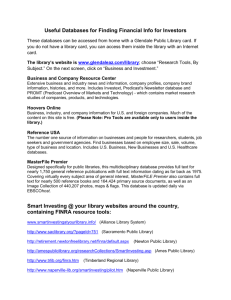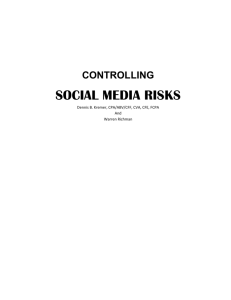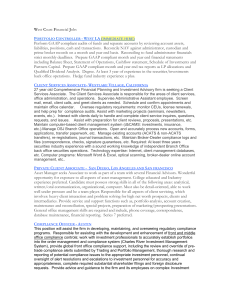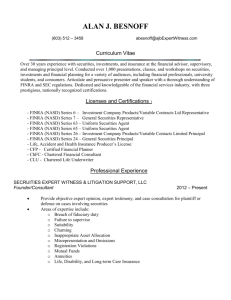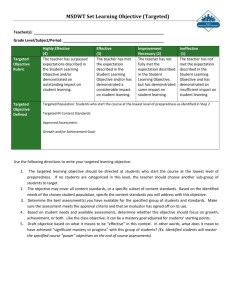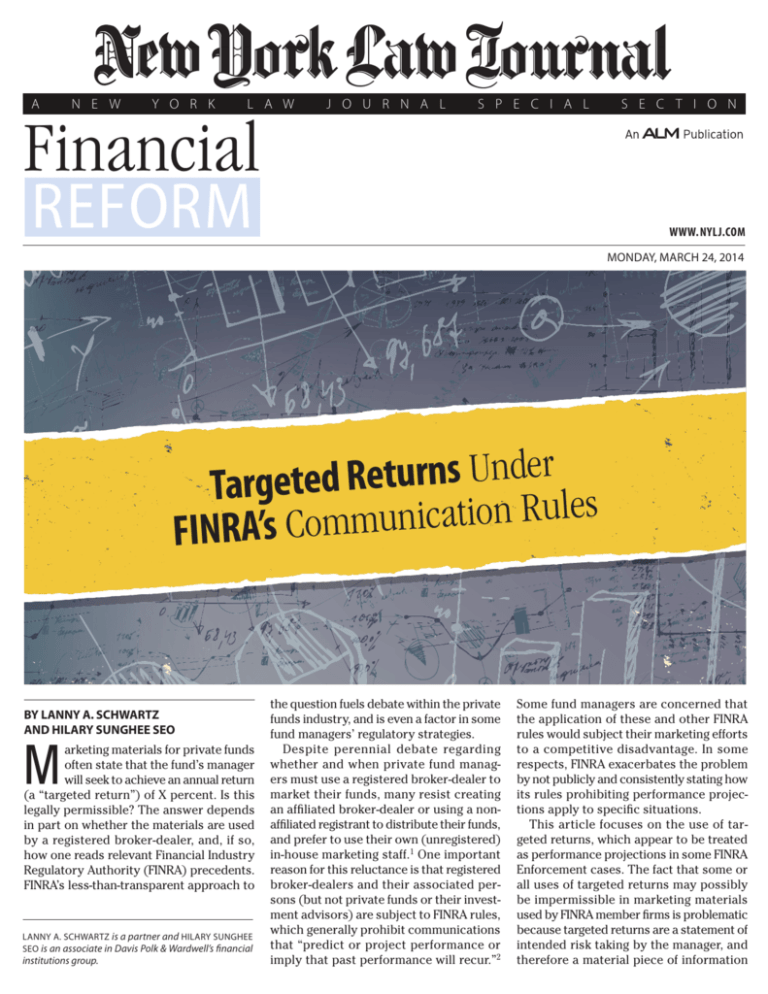
A
N E W
Y O R K
L A W
Financial
J O U R N A L
S P E C I A L
REFORM
S E C T I O N
WWW. NYLJ.COM
MONDAY, MARCH 24, 2014
r
e
d
n
U
s
n
r
u
t
e
R
d
e
t
e
Targ
s
e
l
u
R
n
o
i
t
a
c
i
n
u
m
m
o
FINRA’s C
BY LANNY A. SCHWARTZ
AND HILARY SUNGHEE SEO
M
arketing materials for private funds
often state that the fund’s manager
will seek to achieve an annual return
(a “targeted return”) of X percent. Is this
legally permissible? The answer depends
in part on whether the materials are used
by a registered broker-dealer, and, if so,
how one reads relevant Financial Industry
Regulatory Authority (FINRA) precedents.
FINRA’s less-than-transparent approach to
LANNY A. SCHWARTZ is a partner and HILARY SUNGHEE
SEO is an associate in Davis Polk & Wardwell’s financial
institutions group.
the question fuels debate within the private
funds industry, and is even a factor in some
fund managers’ regulatory strategies.
Despite perennial debate regarding
whether and when private fund managers must use a registered broker-dealer to
market their funds, many resist creating
an affiliated broker-dealer or using a nonaffiliated registrant to distribute their funds,
and prefer to use their own (unregistered)
in-house marketing staff.1 One important
reason for this reluctance is that registered
broker-dealers and their associated persons (but not private funds or their investment advisors) are subject to FINRA rules,
which generally prohibit communications
that “predict or project performance or
imply that past performance will recur.”2
Some fund managers are concerned that
the application of these and other FINRA
rules would subject their marketing efforts
to a competitive disadvantage. In some
respects, FINRA exacerbates the problem
by not publicly and consistently stating how
its rules prohibiting performance projections apply to specific situations.
This article focuses on the use of targeted returns, which appear to be treated
as performance projections in some FINRA
Enforcement cases. The fact that some or
all uses of targeted returns may possibly
be impermissible in marketing materials
used by FINRA member firms is problematic
because targeted returns are a statement of
intended risk taking by the manager, and
therefore a material piece of information
MONDAY, MARCH 24, 2014
that investors naturally expect as part of
their evaluation of the fund investment.
Neither FINRA’s rules nor staff guidance
directly addresses the question of whether
targeted returns in marketing materials per
se violate the ban on projections. However,
recent FINRA Enforcement precedents—
largely, letters of acceptance, waiver and
consent (AWCs) and hearing panel decisions—are inconsistent in their approach
to this issue. FINRA Enforcement has made
some statements suggesting that targeted
returns may be used in marketing materials
so long as they are adequately substantiated
and provide investors with a “sound basis”
for evaluating the target information; other
statements seem to indicate that the use
of targeted returns is a per se violation of
FINRA communication standards.
We believe that, if put in an appropriate
context, the inclusion of targeted returns
in fund marketing materials that are used
by FINRA member firms is beneficial to
investors and should not be treated as a
per se violation. Moreover, if FINRA were to
formally adopt and articulate a pragmatic
and carefully tailored approach to targeted
returns, it might be a small step in blunting
the perception that the use of registered
broker-dealers to distribute a private fund
entails a competitive disadvantage.
FINRA Communication Rules
Under FINRA Rule 2210(d), all member
communications must be based on principles of fair dealing and good faith, be
fair and balanced, and provide a sound
basis for evaluating the facts. No member
may omit any material fact if the omission would cause the communications
to be misleading. In addition, FINRA Rule
2210(d) also contains numerous specific,
prescriptive prohibitions, including the
prohibition in Rule 2210(d)(1)(F), which,
with limited exceptions, prohibits communications that “predict or project performance [or] imply that past performance
will recur … .” FINRA Rule 2210 does not
define what constitutes a prohibited prediction or projection, nor does it mention
the use of targeted returns.
By contrast, the advertising practices
of investment advisors are governed by
the anti-fraud provisions of §206(4) of the
Investment Advisors Act of 1940 and Rule
206(4)-1 promulgated thereunder. While
Rule 206(4)-1 specifies certain advertis-
ing practices deemed to be fraudulent,
deceptive or manipulative, it is generally
less prescriptive than FINRA Rule 2210 and
does not contain a per se prohibition on
projections or targeted returns.
Predictions or projections that have been
the subject of various FINRA warnings and
enforcement actions have come in several
different flavors, including: related performance (generally, the performance results
of funds or accounts managed by the same
advisor or portfolio manager that manages
the fund being promoted); back testing
(generally, model performance showing
how an investment strategy would have
performed under historical conditions);
hypothetical performance; and projected
returns (generally, returns that the fund
manager expects to achieve). FINRA
frowns upon or outright prohibits using
these types of information in marketing
materials, although there have been some
interpretive letters and guidance issued
over the years that provide relief under
limited circumstances.3
Targeted returns are metrics presented for the purpose of communicating to
investors the intended risk profile of the
investment opportunities that the fund
manager will pursue and, viewed in this
light, are somewhat different conceptually from projections.
Treatment of Targeted Returns
There have been a number of FINRA
enforcement actions involving the use of
targeted returns in recent years, but it is
not possible to distill from them a consistent FINRA position. For example, in 2003,
in an AWC involving Altegris Investments,
FINRA Enforcement found that marketing materials promoting hedge funds
that contained targeted returns “failed to
reflect the risks of fluctuating prices and
the uncertainty of rates of returns inherent in these investments.”4 In particular,
it noted that the statement, “[t]he Fund
targets medium-term capital appreciation
of 25% or more per annum with controlled
risk” was problematic because the reference to “controlled risk,” did not accurately reflect disclosure in the offering
memorandum that the investment was
speculative and involved a high degree of
risk. Notably, FINRA Enforcement did not
say in the AWC that the use of targeted
returns was per se problematic.
In another AWC entered in 2004, this
time with Citigroup Global Markets, FINRA Enforcement found that hedge fund
sales literature distributed to existing
subscribers and to qualified prospective subscribers containing targeted
rates of return for particular funds “did
not provide a sound basis for investors
to evaluate the reasonableness of the
stated target.”5 Examples of objectionable statements included: “The Portfolio
seeks to earn an annualized return of 15%
or more, net of all fees, over a three- to
five-year investment horizon …” or “…
targets a 12-14% annual net return …
.”6 Similarly, also in 2004, UBS Financial
Services entered into an AWC in which
FINRA Enforcement found that it had
distributed sales literature regarding
privately placed registered investment
companies that stated that the fund was
seeking a “targeted rate of return, without providing a substantiated basis for
the target to enable investors to evaluate
it.”7 In all of these settled actions, FINRA
Enforcement’s statements seem to imply
that the use of targeted returns was not
a per se violation but violated FINRA’s
communication standards because the
targeted returns were not adequately
substantiated to provide an investor
with a reasonable basis to evaluate the
data. FINRA Enforcement, however, does
not provide any guidance on what would
constitute adequate substantiation in
this context.
By contrast, in 2011, in a disciplinary
proceeding against Hedge Fund Capital
Partners, a FINRA extended hearing panel
found that marketing materials promoting
a hedge fund, and distributed to potential
institutional investors and high net worth
individuals, contained performance projections and therefore violated FINRA communication rules.8 The decision cites in a
footnote various problematic statements,
such as “achieve 15% compounded returns
net of fees”; fund “aims to achieve average long-term returns in excess of 30%
per annum”; “[t]arget returns are 18-22%
net of fees”; and “targeting returns in the
9-13% range.” Thus, unlike in the settlement actions described above, this decision
seems to equate targeted returns with performance projections and classifies them
as a per se prohibited communication.
On the other hand, while difficult to say
MONDAY, MARCH 24, 2014
based on the truncated summary in the
decision, it is also possible that the panel
may have concluded after reviewing the
marketing materials in context that information labeled as targeted returns were in
fact presented as projected returns.
More recently, in 2013, in another prehearing settlement agreement, FINRA
Enforcement found that a broker-dealer
engaged in the private placement of securities for its affiliated private partnerships
distributed marketing materials containing “unwarranted performance projections” including targeted returns.9 The
AWC states that the marketing materials
were distributed to “institutional customers, prospective customers, and, in some
instances, to retail customers.” FINRA
Enforcement does not say that the targeted returns were problematic because
they were presented without providing a
sound basis for investors to evaluate the
reasonableness of the targeted returns.
Rather, FINRA Enforcement’s statement
seems to equate targeted returns with
“unwarranted performance projections”—
for example, the AWC states without
elaboration that “numerous other cyclical communications such as pitch books
discussed ‘target returns,’ ‘risk adjusted
returns,’ ‘projected gross IRR’ or other
comparable projection language, among
other things” and, therefore, constituted
a per se violation of FINRA’s communication standards.
Pronouncements in settled FINRA
Enforcement actions are not precedential,
and like hearing panel decisions, are often
colored by bad facts that are difficult to
separate from related activities that may
not be prohibited standing alone. As a
result, one cannot divine from the materials
reviewed above a consistent set of guidance
to inform members’ practices, particularly
in a nuanced area such as this, and where
FINRA Enforcement’s statements over time
regarding the theory of the enforcement
case as it relates to targeted returns appear
to contradict each other.
A More Practical, Tailored Approach
As statements of the intended underwriting standards of the fund manager concerning future investments, approaches to
leverage and other factors related to the
essential nature of the investment opportunity, targeted returns would be a legitimate and material piece of information that
investors should consider in making their
investment decisions.
If presented in context in a fair and
balanced manner, it would seem to be
appropriate (and potentially material) to
inform potential investors of an emerging
market private equity fund that the fund
will target potentially risky investment
opportunities with expected internal rates
of return in the X percent to Y percent
range. Similarly, it would be useful for
investors to know that a newly launched
real estate fund would seek stable investments that yield current income of A percent to B percent, as opposed to targeting riskier investment opportunities with
potentially higher returns.
Rather than leaving the marketplace in
doubt about the circumstances (if any) in
which a FINRA member may use marketing
materials containing targeted returns, we
believe that FINRA should explicitly permit
the use of targeted returns in appropriate circumstances, if appropriately substantiated
and supported by adequate risk disclosures.
At a minimum, FINRA should:
• Clarify in a rule or in publicly available
guidance when a stated targeted return
would, and would not, be considered a
prediction or projection of future returns.
• Provide specific guidance on what
types of information would be required to
adequately substantiate a targeted return.
This may require information on the method used to calculate the targeted return,
including historical data and modeling
assumptions used to derive the target.
For example, a real estate fund targeting
returns of 10 percent to 12 percent might
present information about the types of
properties in which it will invest, and for
each category of investment, explain its
assumptions about revenues (for example,
based on historical rent rolls and assumptions about market rent growth), expenses
and capital costs to provide a basis for
evaluating the targeted return data.
• Clarify that “operating” projections
(such as projections of rent rolls or
expenses in our example), when presented
as a basis for evaluating a stated targeted
return, would not themselves be prohibited as performance projections, so long
as they are presented in a fair and balanced manner.
• Provide guidance on what cautionary
statements and disclaimers would be necessary to include with targeted returns.10
Conclusion
If properly presented, targeted returns
can provide meaningful information that
can assist investors in their understanding
of investment opportunities. It does not
serve FINRA’s policy goals to have this
information presumptively withheld from
investors—even sophisticated, institutional investors that demand this information—merely because the fund is marketed
through a broker-dealer. By providing
transparent and consistent guidance on
the use of targeted returns in marketing
materials that take into account market
realities, FINRA would not only enable
firms to comply with FINRA’s communication rules with less guesswork, but would
also take a step towards eliminating one
factor underlying some private fund managers’ decisions to avoid marketing their
funds through registered broker-dealers.
••••••••••••••••
•••••••••••••
1. This issue has been the subject of recent commentary
by senior SEC staff. See “A Few Observations in the Private
Fund Space,” Speech by David W. Blass, Chief Counsel, Division of Trading and Markets, U.S. Securities and Exchange
Commission, at the American Bar Association, Trading and
Markets Subcommittee Meeting in Washington, D.C. (April 5,
2013).
2. FINRA Rule 2210(d)(1)(F).
3. See, e.g., Interpretive Letter to Yukako Kawata, Davis
Polk & Wardwell, “Use of Related Performance Information
in Sales Material for Private Equity Funds and Other Similar
Funds” (Dec. 30, 2003); Interpretive Letter to Bradley J. Swenson, ALPS Distributors, “Interpretive Guidance Regarding
the Use of Pre-Inception Index Performance in Institutional
Communications” (April 22, 2013).
4. “NASD Fines Altegris Investments for Hedge Fund Sales
Violations,” NASD Press Release (Apr. 22, 2003).
5. “NASD Fines Citigroup Global Markets, $250,000 In Largest Hedge Fund Sales Sanction To Date,” NASD News Release
(Oct. 25, 2004).
6. NASD Department of Enforcement, Citigroup Global
Markets, Letter of Acceptance, Waiver and Consent (Oct. 4,
2004).
7. NASD Department of Enforcement, UBS Financial Services, Letter of Acceptance, Waiver and Consent, AWC (June
16, 2004).
8. FINRA Department of Enforcement v. Hedge Fund Capital Partners, FINRA Office of Hearing Officers, Extended Hearing Panel Decision (Jan. 26, 2011).
9. FINRA Department of Enforcement, MD Sass Securities,
Letter of Acceptance, Waiver and Consent (March 21, 2013).
10. If FINRA believes that the use of targeted returns is
particularly concerning in the context of offerings to retail
investors who may not be capable of evaluating the reasonableness of the targets presented, FINRA might consider
establishing different standards for institutional and retail
investors.
Reprinted with permission from the March 24, 2014 edition of the NEW YORK
LAW JOURNAL © 2014 ALM Media Properties, LLC. All rights reserved. Further
duplication without permission is prohibited. For information, contact 877-257-3382
or reprints@alm.com. # 070-03-14-25

